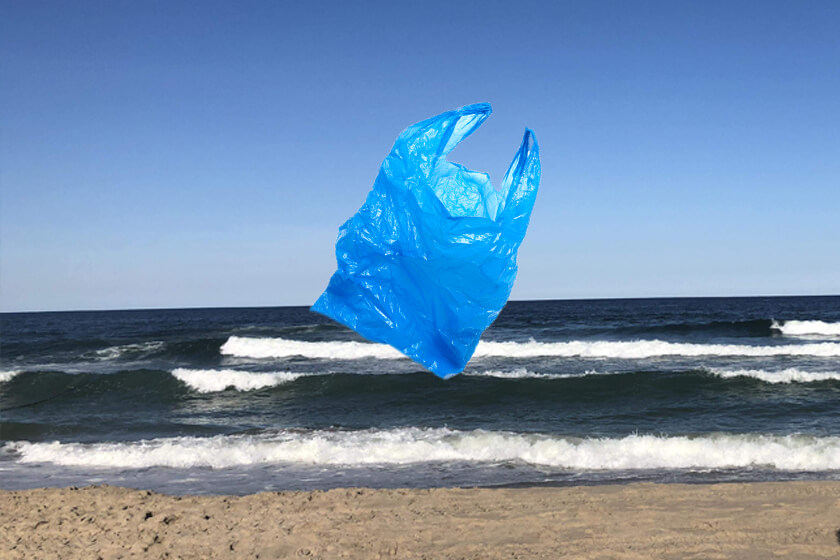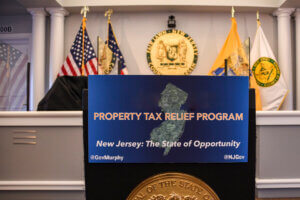West Long Branch, NJ – Most New Jerseyans initially support a single use plastic bag ban, but many back away from that support when considering the impact on consumer shopping habits, according to the Monmouth University Poll. The vast majority of Garden State residents say that ocean pollution caused by plastics is a serious problem, but few have heard much about the issue of microplastics in the environment.
Nearly 2-in-3 New Jerseyans (65%) claim to support a ban on single use plastic bags, while 29% are opposed. Just over half (52%) also say they support a ban on plastic straws, with 44% of state residents opposing this. However, support for a plastic bag ban appears to be less absolute when residents are presented with specific ways this could be handled. When given a number of options, just 31% want a complete ban on single use plastic bags, while 27% say that customers should pay a small fee if they want a plastic bag when shopping. Another 39% of state residents feel that stores should continue to have the option to give away plastic bags for free.
“This is one of the problems with gauging opinion on an issue the public has not really given a lot of thought. The ultimate goal may seem worthy at first, but support wanes a bit when people consider how it might affect them in its implementation,” said Patrick Murray, director of the independent Monmouth University Polling Institute.
New Jersey adults 18 to 34 years old are less likely (31%) than those 35 to 54 years old (40%) or 55 and older (45%) to say that stores should be able to continue giving out plastic bags for free. However, younger adults are not significantly more likely to support a complete ban on providing plastic bags in stores – 33% ages 18 to 34, 33% ages 35 to 54, and 28% ages 55 and older.
The vast majority of New Jerseyans say that ocean pollution caused by plastic products is a serious problem – 64% very serious and 25% somewhat serious. Very few feel it is not too (5%) or not at all (4%) serious. More than 6-in-10 residents of both coastal counties (61%) and inland counties (64%) in New Jersey say this is a very serious problem. Similarly, a majority of state residents ages 18 to 34 (69%), ages 35 to 54 (66%), and ages 55 and older (57%) see plastic products in the ocean as a very serious problem. There are some differences by partisanship – 75% of Democrats, 61% of independents, and 47% of Republicans say this is a very serious problem.
“While the widespread, serious concern about plastic marine pollution reflects the importance the New Jerseyans place on clean water and oceans, there is still a significant disconnect from the need to take personal action when it infringes on the convenience and low cost of plastics in our throw-away society,” said Tony MacDonald, director of the Urban Coast Institute at Monmouth University.
The poll finds that slightly more New Jerseyans think that plastics in the ocean are a major problem when it comes to causing injury to marine life (71%) than say the same for making seafood harmful to eat (60%). Still, large majorities of state residents say both issues are major problems.
Few New Jerseyans say they have heard much about “microplastics,” which are extremely tiny pieces of plastic used in certain products like cosmetics or are caused by the breakdown of larger plastic objects. Just 17% have heard a great deal about microplastics and 19% have heard some. Another 19% say they have heard only a little about microplastics while nearly half (45%) have heard nothing at all. When asked which size of plastic poses a bigger pollution problem, 27% of those polled point to larger plastic objects and 8% point to microplastics. However, a majority (56%) say that both sizes of plastic are equally problematic.
“Since few New Jerseyans have actually heard about microplastics, it is likely that less than one-third of residents statewide actually know something about microplastics and view the environmental risk as seriously as larger plastic objects,” said Murray.
The Monmouth University Poll was conducted by telephone from September 12 to 16, 2019 with 713 New Jersey adults. The question results in this release have a margin of error of +/- 3.7 percentage points. The poll was conducted by the Monmouth University Polling Institute in West Long Branch, NJ.
Monmouth University is hosting a panel discussion on “Marine Plastics: Law, Science and Action” on Wednesday, October 2 at 6 p.m. in Woods Theatre on the university campus. The event is free and open to the public.
QUESTIONS AND RESULTS
(* Some columns may not add to 100% due to rounding.)
[Q1 and Q22-25 held for future release.]
[Q2-21 previously released.]
26. Would you support or oppose a ban on single use plastic bags in New Jersey, such as those given out at supermarkets or other stores?
|
Sept. 2019 | |
| Support | 65% |
| Oppose | 29% |
| (VOL) Don’t know | 7% |
| (n) | (713) |
27. When it comes to single use plastic bags given out at stores, which of the following would you prefer: a complete ban on single use plastic bags, making customers pay a small fee if they want a plastic bag, or allowing stores to continue to give away plastic bags for free?
|
Sept. 2019 | |
| A complete ban on single use plastic bags | 31% |
| Making customers pay a small fee if they want a plastic bag | 27% |
| Allowing stores to continue to give away plastic bags for free | 39% |
| (VOL) Don’t know | 3% |
| (n) | (713) |
28. Would you support or oppose a ban on plastic straws in New Jersey?
|
Sept. 2019 | |
| Support | 52% |
| Oppose | 44% |
| (VOL) Don’t know | 4% |
| (n) | (713) |
29. Do you think ocean pollution caused by plastic products is a very serious, somewhat serious, not too serious, or not at all serious problem?
|
Sept. 2019 | |
| Very serious | 64% |
| Somewhat serious | 25% |
| Not too serious | 5% |
| Not at all serious | 4% |
| (VOL) Don’t know | 2% |
| (n) | (713) |
[QUESTIONS 30 & 31 WERE ROTATED]
30. Do you think plastics in the ocean causing injury to marine life is a major problem, minor problem, or not a problem, or are you unsure?
|
Sept. 2019 | |
| Major problem | 71% |
| Minor problem | 14% |
| Not a problem | 2% |
| Unsure | 13% |
| (n) | (713) |
31. Do you think plastics in the ocean making the seafood we eat potentially harmful is a major problem, minor problem, or not a problem, or are you unsure?
|
Sept. 2019 | |
| Major problem | 60% |
| Minor problem | 15% |
| Not a problem | 7% |
| Unsure | 18% |
| (n) | (713) |
32. There is something called microplastics, which are extremely tiny pieces of plastic used in certain products like cosmetics or they can be caused by the breakdown of larger plastic objects. How much have you heard about these microplastics – a great deal, some, only a little, or nothing at all?
|
Sept. 2019 | |
| A great deal | 17% |
| Some | 19% |
| Only a little | 19% |
| Nothing at all | 45% |
| (n) | (713) |
33. Based on what you may have heard, which do you think is a bigger problem: pollution caused by microplastics or pollution caused by larger plastic objects, or both equally?
|
Sept. 2019 | |
| Microplastics | 8% |
| Larger plastic objects | 27% |
| Both equally | 56% |
| (VOL) Neither is a problem | 2% |
| (VOL) Don’t know | 7% |
| (n) | (713) |
[Q34-41 held for future release.]
METHODOLOGY
The Monmouth University Poll was sponsored and conducted by the Monmouth University Polling Institute from September 12 to 16, 2019 with a random sample of 713 New Jersey adults age 18 and older, in English. This includes 359 contacted by a live interviewer on a landline telephone and 354 contacted by a live interviewer on a cell phone. Telephone numbers were selected through random digit dialing and landline respondents were selected with a modified Troldahl-Carter youngest adult household screen. Monmouth is responsible for all aspects of the survey design, data weighting and analysis. Final sample is weighted for region, age, education, gender and race based on US Census information. Data collection support provided by Braun Research (field) and Dynata (RDD sample). For results based on this sample, one can say with 95% confidence that the error attributable to sampling has a maximum margin of plus or minus 3.7 percentage points (unadjusted for sample design). Sampling error can be larger for sub-groups (see table below). In addition to sampling error, one should bear in mind that question wording and practical difficulties in conducting surveys can introduce error or bias into the findings of opinion polls.
| DEMOGRAPHICS (weighted) |
| Self-Reported |
| 20% Republican |
| 45% Independent |
| 35% Democrat |
| 48% Male |
| 52% Female |
| 29% 18-34 |
| 36% 35-54 |
| 35% 55+ |
| 59% White |
| 13% Black |
| 17% Hispanic |
| 11% Asian/Other |
| 64% No degree |
| 36% 4 year degree |
Click on pdf file link below for full methodology and crosstabs by key demographic groups.




